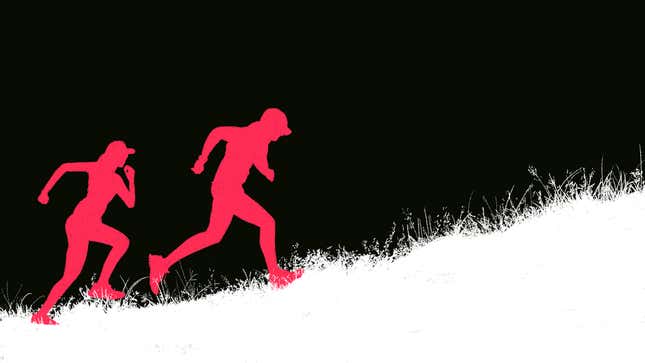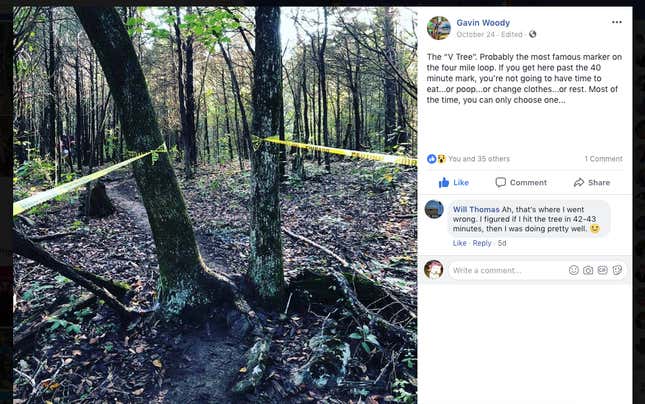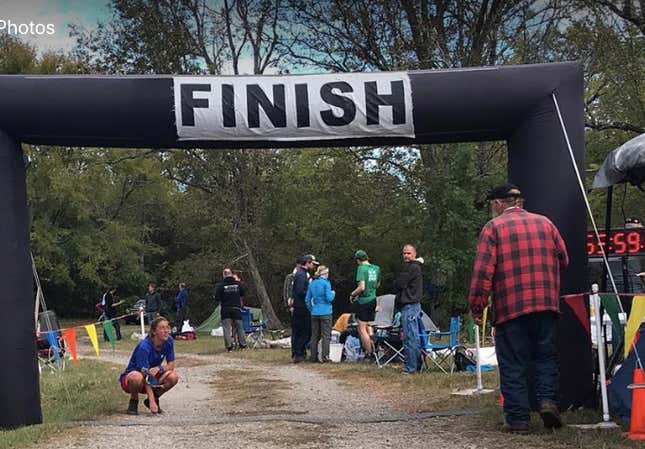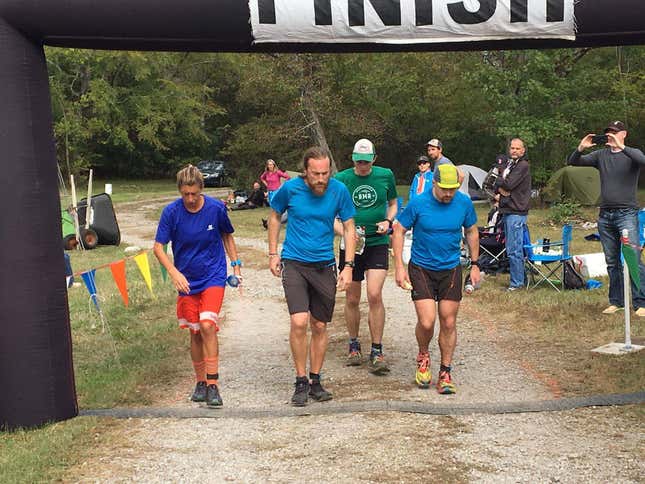
Gary Cantrell clanged a bell at 6:40 a.m. on Saturday, Oct. 20, signaling 70 runners to jog off into the woods on his farm in Tennessee. They had an hour to complete a 4.1667-mile loop trail. Easy. Most of the group finished with 15 minutes to spare. The bell clanged again at 7:40 a.m., and they ran it again. And at 8:40 a.m., and 9:40 a.m., and every hour after that until, one by one, they quit. There was no known finish line. The race went on, day and night, until the bell clanged and only one runner answered.
“I compare it to being punched in the face—light punches,” Cantrell said. “After awhile you just don’t want to get up for it any more.”
Big’s Backyard Ultra is a last-man-standing race devised by Cantrell, a.k.a. Lazarus Lake. He’s the chain-smoking provocateur/mastermind behind the Barkley Marathons, adding Big’s Backyard Ultra to his collection of devilishly difficult programs in 2012. It’s named for his pitbull, Big: “The event, hosted by a dog, in which humans fight to the death,” he quipped.
Endurance races are normally somewhat boring affairs—very little bare-knuckle competition, lots of camaraderie. Pretty much everyone who can drag ass for 50 or 100 miles gets a finisher’s medal and is declared a winner. Everyone gets to go home tired and happy.
That pisses Cantrell off. He’s unapologetically competitive. “Everyone’s not a winner. If you can’t lose, you can’t win,” he said. “A lot of people decry competition as a negative thing. It’s not. You come to love your competitors because you’ve been through this hell together. You don’t want your competitors to quit, but you need them to quit. These things are going on in your head at the same time. That’s a little bit evil. A total mindfuck, runners say.” And he laughed, wheezily.
By hand-selecting a field of “warriors,” and dropping them into a last-man-standing arena, he’s managed to create an endurance event with the coup de gras thrust of bloodsport. “It’s an incredible spectacle to watch. It lends itself to drama,” Backyard’s emperor told me two days prior to the opening bell. “I provide a venue where people can find greatness in themselves. They’ve got a lot of time to let these thoughts coalesce.”
There is no women’s category in Big’s Backyard. The “last man standing” tagline does not mean mankind. No woman has ever won, and Cantrell likes to remind people of that. Prior to this year, Marcy Beard’s 120.8 miles in 2013 (she was among the final three that year) was the top women’s performance, less than half of Guillaume Calmettes’ 245-mile record. But women have been crushing 200-plus mile races, and multi-day sufferfests for years. So why haven’t they performed better at Big’s Backyard?

Cantrell, who got somewhere around 275 applications for this year’s race, had a few ideas: “This format takes away the importance of speed and strength so it levels the playing field for women. Women should do better here comparatively. For one thing, there are fewer women involved in ultrarunning at a serious level. I think socially, women don’t tend to be as competitive as men. But the bottom line is, you have to be willing to suffer.”
If he was trolling Courtney Dauwalter, it worked.
Ponytailed, goofy, and barbed-wire tough, the former high school science teacher from Golden, Colo. doesn’t talk about suffering, but rather about her eagerness to explore the limits of human endurance. Suffering she waves off—it’s a necessary byproduct of her quest for that ever-receding boundary.
She’s a physically gifted athlete, but it’s her head game that sets Dauwalter apart, even in the world of titanium-minded endurance specialists. Soul-crushing landscapes and dog-shit weather don’t even count as annoyances to her. Swirling intestines, hallucinations, a sleep-starved brain struggling with basic cognition, quads so swollen they appeared to be swallowing her kneecaps—her response to this sort of agony is to wonder how much farther she can go.
As for her competitive spirit: She’s won 11 ultras outright, most notably a 10-hour victory over the second place man in the 2017 Moab 240. She’s come second overall in seven other races. Dauwalter told me she considers every person on the start line her competition, not just women, and that few women win overall, as she has, simply reflects greater number of men in ultra endurance events. More than any other woman in ultrarunning, Dauwalter is an open division threat, and that universally competitive mindset is crucial to her success. All of which is to say, she’s made for Big’s Backyard.
Earlier this year, Dauwalter was looking forward to the peculiar challenges (read: horrors) of Big’s Backyard. “I’m hoping this pushes me to see how far I can go, how deep I can dig mentally. You can’t get attached to any distance, and think, ‘that’s when I’ll be done.’ I’m hoping people will stay in for like three days. It’ll bring out some good competition, for sure,” she said. “Most of the guys from last year are in it again—six or seven of them are gunning to pass 200 miles. It’s a cool format, a new way to challenge yourself. I mean, 4 mph is a very sustainable pace, 15 minutes per mile. On paper, you could hold that for a long time, but it’s the head part that gets in the way.”
Dauwalter and her crew, husband Kevin, flew into Nashville and rented a car. Camp was a folding chair, a puffy jacket, and a box of food. She expected to be self-sufficient the first 24 hours, so Kevin could get some shut-eye in the back seat of the rental car. After that, Dauwalter figured she’d need some help. They bought round-trip airfare, returning to Colorado on Thursday, leaving an optimistic five days for exploring the boundaries of human endurance.

Motley tents and jerry-rigged tarps lined the gravel driveway that served as the start and end of the 4.1667-mile loop on Cantrell’s farm. Four porta-potties offered convenience and nothing more. Camp chairs huddled around a fire pit. It was all a primitive arrangement, except for the electronic mat stretching across the gravel, cabled up to the timing equipment adjacent. At night, the electronic clock glowed a hellish red.
Big’s Backyard is Cantrell’s show—he’s the producer, director, and master of ceremonies, expounding every hour. His Facebook posts detailing the nuances and strategies, and latest victims, of the endless loop held a worldwide audience rapt for three days.
Three whistles signaled three minutes until the start of the next loop. Then two whistles, one whistle, a 30-second countdown, then the bell. “Runners come to hate that whistle,” Cantrell said. “By the fourth hour, you hear a groan from the camps when they hear it. It doesn’t take long to figure out what you’ve gotten yourself into.”
Those who failed to show up for the start of a loop were marked DNF. Of all the DNFs, very few timed out, meaning they failed to complete the course in the hour allotted. The vast majority of quitters were sitting in their camps a few steps from the start corral, physically able but unwilling to make their aching body move.
“It’s not a hard trail. They can physically do it, but they lose belief,” Cantrell told me. “When we came up with this format, I thought people would run until they could stand no more, but in fact, people drop when they no longer believe they can win. There’s no reason to continue to suffer if you no longer believe you can win. If you don’t believe you can win, and you’re going to quit at 180 miles, why not quit at 160?”
Each time the contestants shuffled off, the camp was quiet for at least 39 minutes. A fast loop gave runners a few extra minutes in the porta-pottie or to close their eyes before the next bell, but it also exacted a high energy cost. Big’s Backyard is all about balancing pace, stamina, and the things needed to maintain them—tough decisions had to be made. Cantrell told of a runner who only had time to change one sock before the bell. It was another three hours before he found time to change the other sock. Gavin Woody, one of the final three survivors, explained the realities in a Facebook post:

Over the course of the the first night Dauwalter minimized her time in the camp: “We didn’t have a shelter that first night—just a chair and puffy coat. When I came in from a loop, I’d bundle up, sit quick, and try to eat something, but it was pretty chilly. I took my time on the loops so I wouldn’t have to sit, so I wouldn’t get so cold,” she said.
Bad patches are the one constant in endurance races. Normally runners can take an hour or so to rest or eat or vomit or whatever it takes to regroup and carry on. Not at Big’s. “A few years ago, Babak Rastgoufard had some stomach problems, he literally turned green, and couldn’t make it to the start [before the next bell],” Cantrell said. “An hour later he was fine. That’s the cruel thing about the Backyard—you can’t have one bad hour.”
The way Big’s keeps its competitors in such close proximity adds another layer to the competition: the need to maintain a cheery facade. Dauwalter foresaw the implications: “You’re going to go through a low point sometime. In a normal ultra, if you break down and shed some tears, you can find an isolated rock to sit on. No one sees you break. But in this format, you’re always visible to each other. I saw a few photos from last year’s race and Guillaume [the eventual winner] was cheesing it up, super positive the whole time. There’s going to be some head games being played, for sure.”
By the start of the second day, with 100 miles pounded into their legs and nothing that would count as sleep, 30 competitors remained. The favorites—Dauwalter, Guillaume Calmettes, Maggie Guterl, Joe Frejes, Johan Steene, Andres Villagran, Peter Cromie, Andy Pearson—were just getting started, though a few had already fallen. And every drop came as a surprise to the other runners—she had looked so good.
“They do a great job of never showing weakness” Cantrell said. “You’ve never seen a group of people with fewer complaints. If you stand around in the start corral, they’ve never felt better, but in their camps they’ll say, ‘Everyone’s feeling better than me,’ and their crew will have to say, ‘No no, everyone’s dying.’ Your opponent won’t quit if they think you’re about to go out. If they hear you complaining or looking bad, even if they were going to quit, they’ll say, ‘Scratch that, I’m going on.’”
Throughout the second day, there was steady attrition. The previous women’s top performer, Marcy Beard, dropped at 30 hours, having broken her own mileage record by one loop. Ecuadoran Andres Villagran, who had been looking invincible, gave up at 38 hours and 158.3 miles. He had been routinely hammering out 39-minute loops, but in a pattern that spelled imminent doom for many, his 36th, 37th, and 38th loops were over 50 minutes.
Consistency seemed to be the key, and the remaining runners’ loops varied by only a minute or two, most in the 45-minute range. But the weakening effect of enormous mileage, mere minutes of sleep, minimal hygiene, and obligatory eating was undeniable. There was less chatting. Competitors, some favoring a knee or hip, crossed the mat and immediately disappeared into their tent or their camp, sat, ate, drank, changed socks, closed eyes. “Life existed between the whistles,” Dauwalter told me when we talked after the race. “All you had to do was make sure you were back in the start corral.”
On the first day, runners responded to the three-minute whistle; by the second day, no one got out to the start corral before the 30-second countdown, trying desperately to take advantage of every second of rest. No one except for Dauwalter, that is.

“At the 30-second countdown, when no one was in the starting corral with me, it crossed my mind that maybe they weren’t coming, maybe they quit. But 30 seconds is an eternity. Like clockwork, they’d come strolling over with 15 seconds to go. You can’t let yourself think like that,” she said.
The 44th hour, in the depths of the second night, claimed Maggie Guterl, Dauwalter’s running buddy and the only other woman left in the field. The happy news for Dauwalter was that Guterl immediately offered her tent. Small things like a warm place to rest, Dauwalter said, helped her stay in the game longer.
“My eyes were droopy and I was seeing a lot of weird things—a giant 12-foot tall cowboy with a yellow bucket hat twirling a rope, an ice castle, people lining up along the road. That was during the daytime,” she said. “At night, out on the road I tried to let my eyes close. Sometimes I started thinking about how much further we might go but I consciously brought myself back to stay in the loop. I tried to keep any doubts or breaking on the inside, even from my crew. Vocalizing didn’t help anything. Somewhere in the early 200-mile range, I may have told my crew that my legs were really tired.”
Guterl’s drop, at 183.3 miles, left five desperadoes in it for the long haul: last year’s champion, Guillaume Calmettes; two guys with good but not great endurance résumés, Greg Salvesen and Gavin Woody; Johan Steene, a Swede and former Big’s Backyard winner who’d also had a go at Barkley and had tons of multi-day racing to his credit; and Dauwalter. Eight hours ground by like an eternal root canal. No one talked, no one blinked, no one dropped. Then, suddenly, Calmettes barely finished the 52nd loop—59:42. He seemed to recover somewhat on the 53rd, finished the 54th in 53:13, and was done.

Dauwalter’s next loop was one of her fastest, and Cantrell wondered aloud if it was a statement of her confidence. Facebook spectators seriously entertained the possibility that the last man standing might be a woman. “If I wanted a few more minutes to change shoes or rest, I tried to be a little more efficient, faster in the loop, but there was no psychological warfare going on out there. I was not worrying about sending a message—my brain was not processing well enough for that,” explained Dauwalter.
Fifty-six hours and 233.3 miles in, Greg Salvesen caved. Nine awful hours (think what you’ve done in nine hours, with benefit of a night’s sleep) and another 37 miles (let’s think about how you feel after a single 26.2-mile marathon) later, Gavin Woody laid down his cross. He’d made it 270.8 miles. Then it got dark for the third time. Only Johan Steene and Dauwalter remained.
“Everything hurt—knees, hips, feet,” Dauwalter said. “My arms were so tired, carrying a cup of water was hard. I had been faking my way through it for awhile. I was coming back on the last night with 12 minutes left. I’d eat a couple bites, try to shut my eyes, but I never had that magic nap where you wake up and feel completely refreshed.”
The whistles—three, two, one—the 30-second countdown, the bell clanged for the 66th time in 66 hours, and Steene and Dauwalter leaned forward, hoping their flayed legs would hold up.
“Johan and I were not running together. He was doing 46-minute loops and I was falling off. We’d see each other but we weren’t chatting. There was no energy for chatting. And no, I didn’t see him quitting. He was so strong, visibly running smoothly,” Dauwalter said. “We were all hiding that it was hurting; maybe that was chipping away at him too.
“There was nothing make-or-break, but slowly accumulating wear and tear, until it’s suddenly too much to overcome. It happened with Gavin—he looked totally fine. No one was showing weakness, no one seemed to be struggling to run, and suddenly, it was one too many steps. That’s what happened to me. The last two loops were a death spiral and then it was over.
“I was out. I was done, no more left. There was no more gas in the tank. If I had gone out for another loop, I’m not sure I would have made it. I would have been crumpled up out on the road somewhere. I was decently taking in food but I hadn’t actually slept. I’d been chipping away at my reserves for 67 hours and there was nothing left to chip. It wasn’t one thing, it was a zillion tiny things.
“After the 67th loop, I went into the tent, my crew was there. They did all the things we’d been doing, talking to me about getting back out for another loop, but all I wanted to do was shake Johan’s hand and send him out so he could enjoy the last lap. I didn’t want to pretend to start; I wanted him to know it was his last lap.”
In the dead darkness of Tuesday morning, 67 hours and 279 miles after they’d started, two battered warriors shuffled to the start corral. Dauwalter said a few words to Steene. They shook hands, the starting bell clanged, and Steene tottered off into the blackness alone. In the uncompromising world of Big’s Backyard, Dauwalter quit, and was marked, like 68 others, DNF.
Steene described his required victory loop in a Facebook post: “At the moment when Courtney congratulated me and remained in the coral as I jogged away alone into the Tennessee night I didn’t feel joy. I felt empty and without purpose. You can not carry the illusion by yourself. It takes at least two to play. Thanks Courtney Dauwalter for taking us this far. We are good at playing this game.”
Steene’s 283 miles, run over the course of nearly three days, is a new Big’s Backyard record, well beyond Calmettes’s 245 miles, and his own 2014 winning distance of 204 miles. But the key player in this brutal game was Dauwalter. She pushed Steene into uncharted territory. Her 279 miles obliterated the previous top women’s mark of 120 miles, and was, in fact, more hours and miles than she’d ever run. This was not a great woman’s performance; it was an extraordinary human achievement. Two-hundred-seventy-nine miles is the farthest anybody, save one, has ever run at Big’s Backyard.
Typically, Dauwalter’s takeaway from the race had nothing to do with how much she had suffered and endured, nor about winning or losing or strides made for women, but about learning: “I feel pretty good about how it played out now that I’ve had night of sleep and a shower. Yeah, my legs hurt really bad and that’s probably going to get worse over the next couple days, but already I’m thinking about next year’s race, what we can do differently so we’re out there even longer. I want to come back and go into the 300s. Kevin and I have never done anything close to this. We learned so much—all the ways we can work more efficiently, gear and food that would have been helpful. To have this cool experience—I was lucky to be a part of this.”
As Cantrell predicted, in Big’s unrelenting arena, Dauwalter was able to find greatness in herself. She did have a lot of time for those thoughts to coalesce.